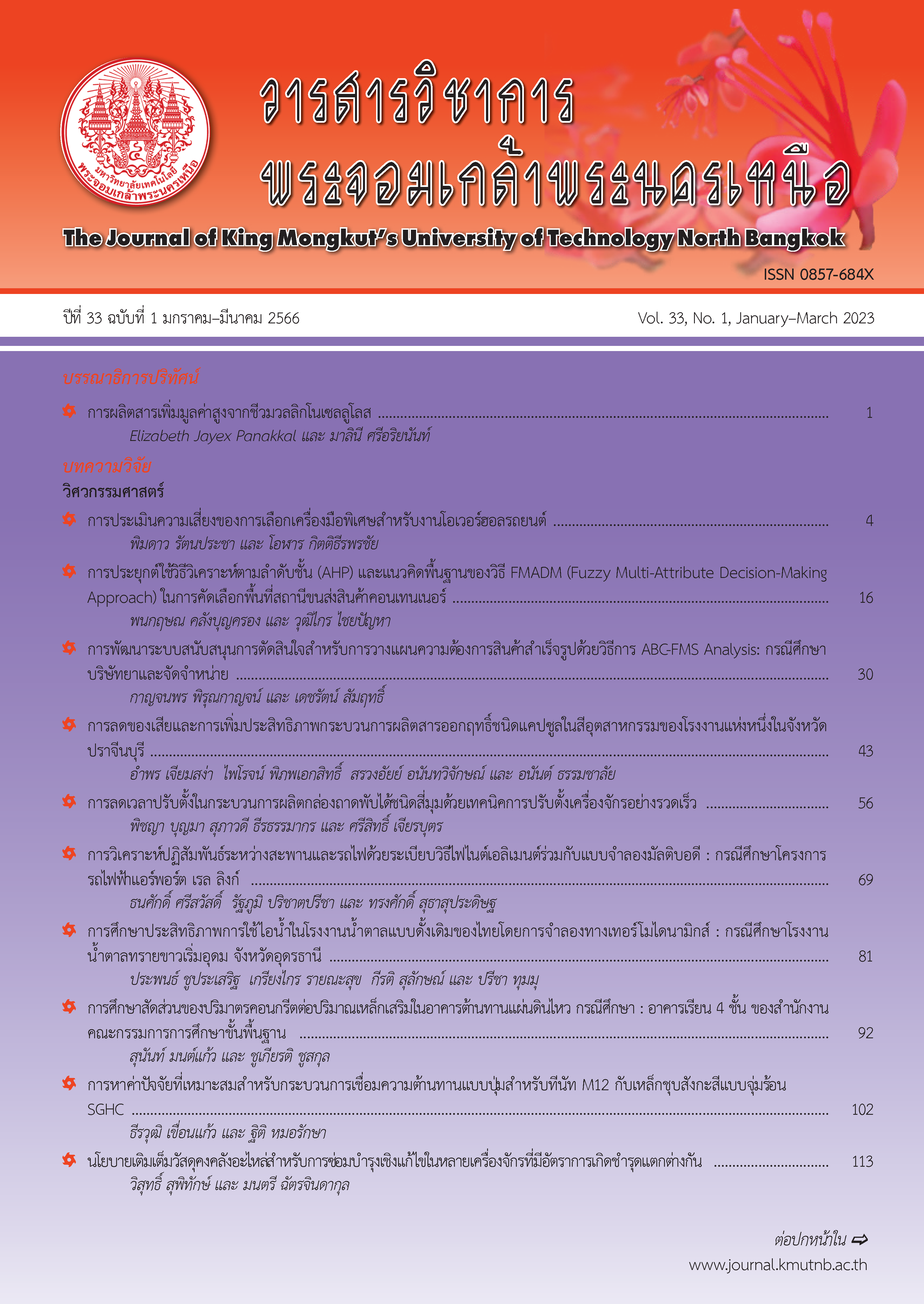Risk Assessing of Selecting Special Tools for Automotive Overhaul
Main Article Content
Abstract
Fueled by the fierce competition, Thailand automotive companies have offered a wide variety of alternatives to ensure consumer satisfaction, including after-sale services. Despite the strategic emphasis on after-sale services, many standard service centers have faced the service dilemma as some overhaul services require special tools designed for a specific model with a long manufacturing lead time. Coupled with a recent changing of purchasing policy, some service centers delayed purchasing such tools. This affects the readiness and standard of a service center, causing unsatisfactory consumers’ experiences, such as delay of services, and repeated visits. This study applied the risk matrix that addresses the trade-off between additional costs and service benefits in the selection of an individual special tool and proposed three purchasing guidelines with a discrete-time event simulation model. The model simplified vehicle models and repairing tasks that share common service bays and special tools. The result of the model reveals that the availability of special tools provides a better service level with few minutes increasing of waiting times. When no special tool requires for repairing tasks, the processing times are statistically identical. However, the processing time can be significantly reduced when special tools are required. In addition to a better service level and processing time reduction, the purchasing of partial-set special tools is recommended based on the Risk Matrix and the cost and benefit ratio.
Article Details

This work is licensed under a Creative Commons Attribution-NonCommercial-NoDerivatives 4.0 International License.
The articles published are the opinion of the author only. The author is responsible for any legal consequences. That may arise from that article.
References
B. Langner and V. Seidel, “Collaborative concept development using supplier competitions: Insights from the automotive industry,” Engineering and Technology Management, vol. 26, pp. 1–14, 2009.
E. González, A. Cárcaba, and J. Ventura, “How car dealers adjust prices to reach the product efficiency frontier in the Spanish automobile market,” Omega, vol. 51, pp. 38–48, 2015.
E. Legnani, S. Cavalieri, and S. Ierace, “A framework for the configuration of after-sales service processes,” Production Planning & Control, vol. 20, no. 2, pp. 113–124, 2009.
S. Shokouhyar, S. Shokoohyar, and S. Safari, “Research on the influence of after-sales service quality factors on customer satisfaction,” Retailing and Consumer Services, vol. 56, pp. 1-11, 2020.
U. Dombrowski and C. Malorny, “Process identification for customer service in the field of the after sales service as a basis for “Lean After Sales Service”,” Procedia CIRP, vol. 47, pp. 246–251, 2016.
P. Gaiardelli, N. Saccani, and L. Songini, “Performance measurement of the after-sales service network—Evidence from the automotive industry,” Computers in Industry, vol. 58, pp. 698–708, 2007.
N. Saccani, P. Johansson, and M. Perona, “Configuring the after-sales service supply chain: A multiple case study,” International journal of Production Economics, vol. 110, pp. 52–69, 2007.
K. Aboltins and B. Rivza, “The car aftersales market development trends in the new economy,” Procedia - Social and Behavioral Sciences, vol. 110, pp. 341–352, 2014.
T. Meyer, “Engineering risk management,” De Gruyter, pp. 151–155, 2016.
A. Pinto, Industrial and Systems Engineering Collection, Momentum Press, pp. 17–26, 2015.
R. Wang and J. Wang, “Risk analysis of out-drum mixing cement solidification by HAZOP and risk matrix,” Annals of Nuclear Energy, vol. 147, 2020.
C. Domínguez, I. Martínez, P. Peña, and A. Ochoa, “Analysis and evaluation of risks in underground mining using the decision matrix risk-assessment (DMRA) technique, in Guanajuato, Mexico,” Journal of Sustainable Mining, vol. 18, pp. 52–59, 2019.
P. Buapim and A. Ketsakorn, “Risk assessment by the fault tree analysis (FTA) and analytic hierarchy process (AHP) of infectious waste management in health promoting hospital,” The Journal of KMUTNB, vol. 29, no. 3, pp. 465– 480, Jul.-Sep. 2019 (in Thai).
S. Moss, L. Ulber, and I. Hoed, “A herbicide resistance risk matrix,” Crop Protection, vol. 115, pp. 13–19, 2019.
O. Frough, A. Khetwal, and J. Rostami, “Predicting TBM utilization factor using discrete event simulation models,” Tunnelling and Underground Space Technology, vol. 87, pp. 91–99, 2019.
M. Kamrani, S. Abadi, and S. Golroudbary, “Traffic simulation of two adjacent unsignalized T-junctions during rush hours using Arena software,” Simulation Modelling Practice and Theory, vol. 49, pp. 167–179, 2014.
J. Lin, B. Gao, and C. Zhang, “Simulationbased investment planning for Humen Port,” Simulation Modelling Practice and Theory, vol. 40, pp. 161–175, 2014.
L. Aboueljinane, E. Sahin, Z. Jemai, and J. Marty, “A simulation study to improve the performance of an emergency medical service: Application to the French Val-de-Marne department,” Simulation Modelling Practice and Theory, vol. 47, pp. 46–59, 2014.
A. Jeddi, N. Renani, A. Malek, and A. Khademi, “A discrete event simulation in an automotive service context,” IJCSI International Journal of Computer Science Issues, vol. 9, pp. 142–147, 2012.
K. Grzybowska and M. Kostrzewski, “The application of simulation methods in the comparative analysis of car spare parts distribution system,” Logistics and Transport, pp. 5–16, 2016.
A. Verma, D. Tahlyan, and S. Bhusari, “Agent based simulation model for improving passenger service time at Bangalore airport,” Case Studies on Transport Policy 8, pp. 85–93, 2020.
T. Carbone and D. Tippett, “Project risk management using the project risk FMEA,” Engineering Management Journal, pp. 26–35, 2015.
W. Kelton, R. Sadowski, and N. Zupick, Simulation with Arena, New York, USA: McGraw-Hill Education, 2015, pp. 53 – 110.
W. Winston, Operations Research: Applications and Algorithms, Belmont, USA: Brooks/Cole, 2004, pp. 1064.

